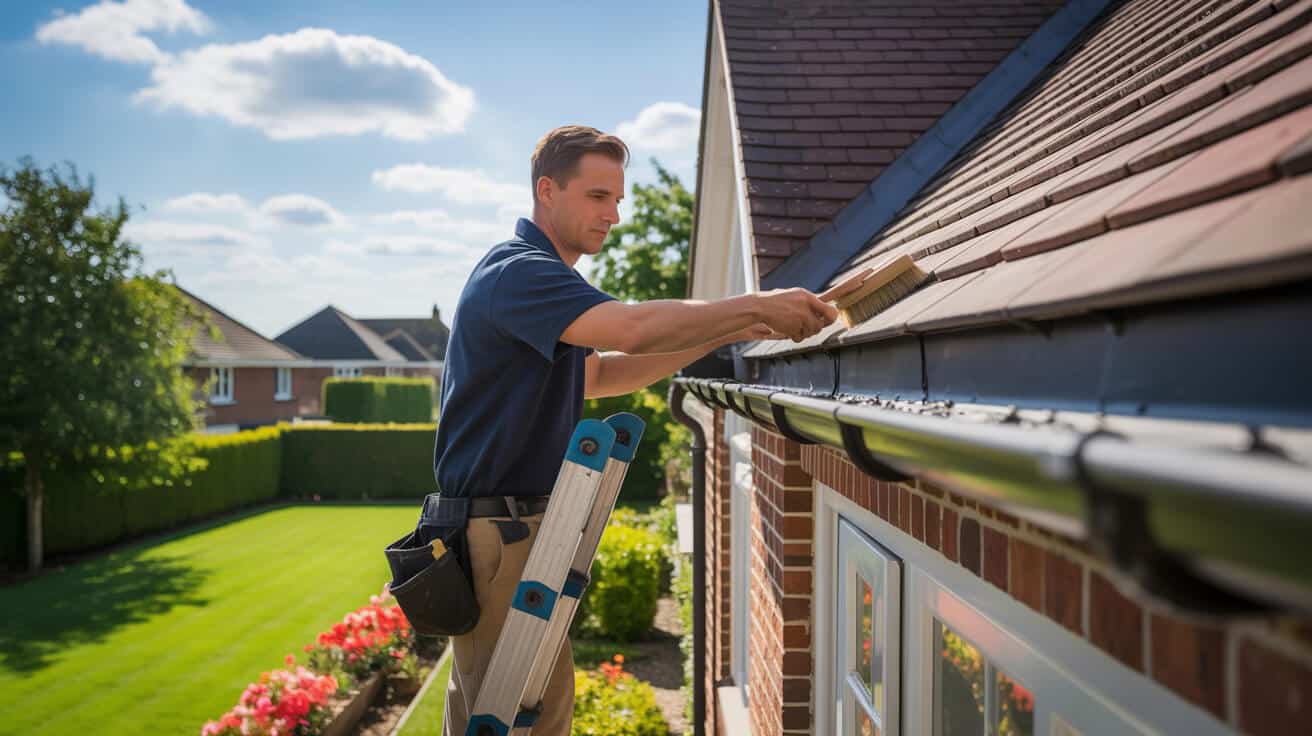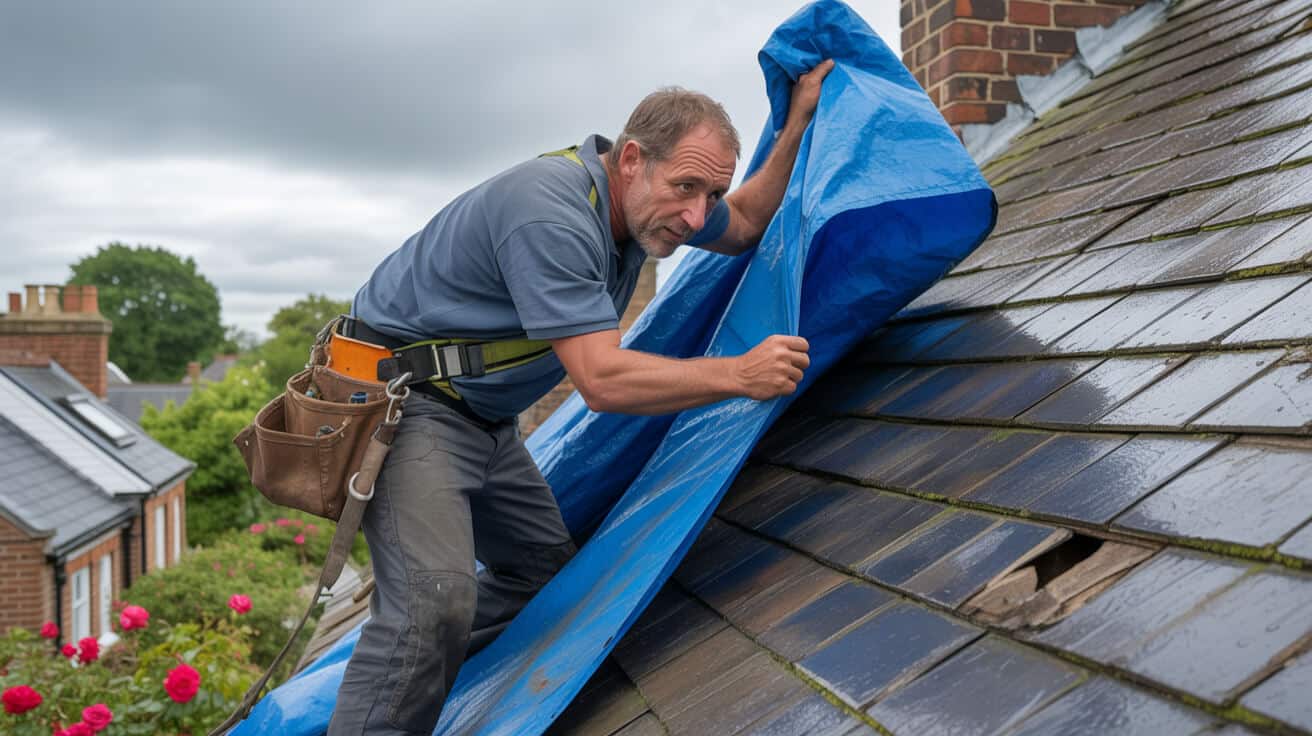 Is Your Property Ready For A Storm A Wind And Flood Resilience Checklist
Is Your Property Ready For A Storm A Wind And Flood Resilience Checklist

Do You Really Know If Your Property Is Storm-Ready—or Just Lucky So Far?
When the wind shrieks and rain hammers down, your property’s resilience is no longer hypothetical. Each bolt, bracket, and bit of paperwork becomes either a shield—or a weakness that costs you, your tenants, and your bottom line. For UK property owners, managers, or block stewards, storms are an exam graded in water, wind, and paperwork. There’s no mercy curve. Real resilience comes from discipline—layered checks, proper documentation, and proactive upgrades—so you can sleep through the howling and get on with life while others scramble.
A last-minute scramble is just a checklist left unfinished. Peace of mind is planned, not wished for.
This guide isn’t theory. Every step is shaped by Hector Gauge, multi-trade property specialist at All Services 4U, who’s seen the difference between “looked fine last week” and “how did this happen?” You’ll get practical, up-to-date UK advice—no jargon, no luck games, just calm, professional action you can actually use. Whether you’re keeping a riverside flat safe, ticking boxes for a letting agent, or securing your own family’s roof, you’re the difference between order and chaos this storm season.
How Can You Actually Measure Your Storm and Flood Risk—Not Just Guess?

You can’t fix what you can’t see. Every year, UK owners who “thought they were fine” watch water and wind go exactly where the weather office always said it would. They’re shocked at denied claims or slow insurance because “that problem wasn’t on the survey” or “it looked new after we painted.” When it comes to resilience, only knowledge and honest self-audits keep properties out of the headlines and your bank account out of trouble.
Accurate Risk Mapping—Done Right
Start Here:
- Check Your Postcode and Microclimate: The South West, North West, and all river valleys are hotspots—floodplain or exposed hill, your local council risk map and the [Environment Agency’s flood map](https://www.gov.uk/check-long-term-flood-risk) will show threats more accurately than old estate agent plans.
- Understand Real Costs: Storm or flood claims commonly run £5000+ in 2023 (Centurisk). Major ground-floor floods or structural wind damage? Expect £12,000+ in repairs, not counting loss of rent or forced hotel bills.
- Factor in Real-World Impact: If you run a property business, storm losses are more than money—they’re missed occupancy, tenant distress, and reputation bruises while insurers argue over evidence.
Disaster isn’t random—it runs like water through every unlabeled weakness.
Actionable Move:
Map your main structures, outbuildings, drainage, and ground level entries. Don’t skip ground-floor or basement risks—these are insurance favourites for denying swift claims if the paperwork doesn’t match the physical reality.
Common Traps That Blindside Owners
Even brand-new paint and “last year’s roof” can mask trouble. Most claim disputes in the UK happen not because damage is sudden, but because evidence of existing problems, or recent repairs, was missing, incomplete, or never logged. If you can’t quickly show recent audits or receipts, you’re betting your property’s future on memory and good faith.
Insider Win:
Block 30 minutes in your calendar for an honest, written self-audit (ideally with photos). Your future self—and your future insurer—will thank you.
Which Weak Spots Turn a Storm Into a Disaster Fastest?

Storms don’t just “appear unlucky”—they attack the overlooked, the hastily “sorted”, and the jobs scribbled onto next season’s to-do list. One missed screw or loose fence panel can set off thousands in damage within minutes.
Danger Zones: Where Storm Damage Starts
- Roof Design and Fixings: Gable roofs (especially semi-detached homes and older blocks) are up to 40% more likely to fail in severe wind than hipped types, particularly if tiles, flashing, or ridge brackets are loose or corroded (mdpi.com).
- Windows, Doors, Seals: Gaps, missing weather-strips, or tired locks mean wind and water enter at speed—and insurance claim photos tell the full storey.
- Perimeter and Mobile Hazards: Anything you can pick up—bins, potted plants, deck chairs, overgrown branches—can be picked up by wind and slammed into windows, doors, and drains.
- Substructure and Airbricks: Neglected or poorly sealed airbricks allow water to surge under your property—one missed detail becomes the reason a home or business is out of action for months.
Luck in weather claims usually means small tasks put off too many times.
Hector’s Hands-On Field Audit
Roof & Loft
Physically check each tile—loose or cracked ones leak fast. Test flashings and ridge lines. Don’t trust them just because they “looked fine.” Chimney and solar instal flashing: firm, sealed, not lifting.
Entry Points
Check lock function, door hinge alignment, draught seals, and upgrade thresholds now, not after the first puddle. Photograph receipt and compliance documentation—especially for security doors.
Outbuildings & Fences
Lock, anchor, and reinforce anything freestanding. Weathered sheds become lethal debris. Fences—tighten all anchors, cross-brace weak panels, and trim overhanging trees.
Water Routing
Pour water down gutters and pipes, not just visually inspect. Mesh guards stop blockages; missed connections or pooling at downspouts spell future rot and legal headaches.
Grounds & Gardens
Clear walkways, stack or store loose items, reinforce bins. It’s £15 of prevention versus weeks of soggy cleanup.
Key Reminder:
Every unchecked hotspot is tomorrow’s denial letter or the reason tenants start looking elsewhere.
What Are Actual, Immediate Steps to Boost Storm and Flood Readiness—Today?

“Hope is not a plan.” Real resilience is about processes, not promises. The properties that weather storms best are the ones whose owners break the inertia early—before the red warnings go out.
Rapid-Readiness Playbook
- Self-Sufficiency Kits: Store 2-3 days of bottled water, non-perishable food, torches, batteries, and first aid together, within easy reach—especially in high-occupancy or vulnerable settings.
- Rescue Your Records: Scan and waterproof all contracts, tenancy agreements, compliance certs, and essential contacts. Back up everything to cloud storage AND off-site USB.
- Plan for People: Account for any at-risk users—older adults, children, or disabled residents—when composing your emergency plan. Roleplay at least once per year. Government advice: [Prepare Campaign](https://prepare.campaign.gov.uk/get-prepared-for-emergencies/).
Those who just let everyone know by WhatsApp recover cleaner and claim faster.
Next-Level Moves From All Services 4U
- Emergency WhatsApp/Group Text: Assign roles for each tenant or user—who secures outdoor assets, who checks fuse boards, who leads evacuation protocols? Confirm in writing.
- Image Logs: July and November—run a round of “before/after” photos for insurance, showing every key asset—roof, entryways, outbuildings, fences. These are evidence gold.
- Shared Asset Checklists: In flats or blocks, define who checks which perimeter assets and document actions with names/dates. No one gets to say, “Wasn’t my job.”
Do This Before Autumn:
Book one calendar date to test your plan and update your digital/physical logs, not just “hope you remember.”
Which Upgrades Have the Highest Payout in Storm and Flood Risk Reduction?

Property resilience isn’t built with one-off spending. It’s about selectively investing in the right upgrades—then tracking and proving you did so, for both legal protection and actual safety.
High-Impact Upgrades That Save Real Money
- Storm Shutters, Impact Glazing: Instal these on exposed faces. Studies show properties with impact glazing have up to *80% fewer claim incidents* (RealManage).
- Modern Sealants, Downpipe Hardware: Replace decayed sealant, cracked corner flashing, and perished door/window strips. The £60 you spend now might block £10,000 in water damage.
- Secure Fixings: 75mm+ screws, continuous hinge-plates, and weather-resistant anchors for all doors, sheds, and gates. These outperform “quick fixings” during wind events—keep all receipts.
£25 missed on a simple upgrade is the root cause of many five-figure insurance disputes.
Hector’s Upgrade Checklist
- Record Evidence: For every upgrade—especially windows, doors, structural—upload time-stamped photos, receipts, compliance notices, and warranty info to a single offsite folder.
- Portable Flood Barriers & Backflow Valves: For ground floors or flood-zones, instal backflow valves and document with video and timestamp.
- Gates & Outbuildings: Never let minor exterior jobs roll over to the following year. Storms find the smallest error—schedule upgrades for summer completion when possible.
Budget Rhythm:
Ring-fence a modest, recurring annual budget—£100-£300 covers the majority of “little” jobs that add up to saved claims and less crisis.
Why Are Roof and Gutter Checks the Most Overlooked Yet Highest-Impact Routine?

Roof and gutter failure is the difference between “annoyance” and “nightmare”. Every year in the UK, properties with seemingly minor issues—moss, a loose vent, an uninspected outflow—become insurance horror stories or weeks-long maintenance sagas. The difference is 30 minutes of discipline at the right time.
Roof Health: Your First—and Costliest—Line of Defence
- Physical Inspection: Stand safely, use a pole camera if needed—tap every tile. If it moves or sounds hollow, document and fix before autumn.
- Chimneys, Vents, Flashings: Watch for leaning chimney pots, perished camber, and especially cracked or loose flashing. These are the quickest way for water to destroy insulation and electrics. Document with smartphone video.
- Mounted Equipment: Solar panels, satellite dishes, roof window brackets—these points often fail under gusts if not to manufacturer spec.
One day and a £500 scheduled check can save you facing a £8000 loss.
Gutter and Downpipe Mastery
- Water Test, Not Just Visual: Flush through each section—blockages don’t always show up during dry weather. Fit mesh guards and replace old brackets.
- Overflow Checks: Direct all overflow runoff away from base walls—this often bypasses damp proofing and creates “mystery” structural damage if ignored.
Proof Pays:
Take photos or video of every cleaned and checked section. If your claim needs it, timestamped digital evidence is now the standard for insurers—not a handshake, and not hope.
What Are the Real Structural Moves That Reduce Disaster Odds by 40% or More?

You don’t need to rebuild your property for it to stand up to storms. What actually prevents catastrophic loss is a sequence of hard-won incremental wins—each one simple, but together, nearly bulletproof.
Key Structural Wins—No Drama, Pure Results
- Fixings & Anchor Points: Use modern, code-compliant bolts and screws for all exterior features—proven to drop storm-failure odds by 40% (mdpi.com).
- Timed Jobs—Never Start Before a Storm Month: Don’t tempt fate by letting scaffolds, partially replaced siding, or half-painted windows linger as the leaves change. Incomplete work is the #1 cause of “unlucky” storm claims.
- Materials Sheet: Log every major material—roof tiles, anchors, weather-proofs—in your own database. It’s the easiest way to prove you didn’t cut corners or use inferior supplies.
The longer a checklist sits half-finished, the sharper the odds of a compliance or insurance headache.
For Professional Managers and Portfolio Owners
Missed checks multiply risk across your entire site list—one forgotten roof brings the rest into your insurer’s crosshairs if audit reveals a pattern.
Best Move:
For any major exterior or structural work, bring in certified contractors or building control for proper signoff—document with digital and paper backups together.
How Do You Build Storm-Proof Insurance Claims from Day One?

Insurance doesn’t pay out on good faith or “trust me, we did it.” It pays on detailed evidence, provided before the adjuster even asks. If you want frictionless claims—especially under post-storm volume—your documentation already needs to exist.
Ironclad Claims Tactics
- Digital Everything: Photograph and scan before/after every job, upload redundantly. Everything lives in the cloud. Assume “wet copies” will be destroyed or misplaced in a flood.
- Immediate Policy Sync: Update your agent after every significant upgrade. Undisclosed work—even when done by the book—can void claims (Centurisk).
- Demand Audit Trails: For works over £1000 or any “critical” component (roof, structure, electrics), get a formal sign-off, stamped receipt, or compliance certificate—don’t accept verbal reassurance from a tradesperson.
Owners who retrieve digital folders by request win fast, full claims. Others wait months.
Routine Is Resilience
Make quarterly compliance tasks as regular as rent day—just another scheduled admin. Fast claims become frictionless when your digital and compliance logs tell the right storey at the right time.
What Guaranteed Steps Turn Storm Anxiety into Smart, Unshakable Control?
Your next-level safety isn’t out of reach or reserved for paranoid types. Resilience is won by turning intention into rhythm—pre-storm, post-storm, every season, every asset.
Three Moves from “Vulnerable” to “Bulletproof”
1. Download Hector Gauge’s All Services 4U Checklist
Get the up-to-date, interactive checklist with UK-specific tasks, ready-to-use proof templates, and compliance reminders. Not another PDF to ignore—this is your living tool for ticking, snapping, and emailing as proof.
2. Book an Actual Storm Audit—Not Just a Gut Check
Best done early spring or after autumn clean-ups, audits pay for themselves with every “hey, actually that’s already fixed” repair or smoothed claim.
3. Request a Real Quote—Understand What’s Certified
All Services 4U provides line-by-line, transparent quotes—each item mapped to compliance, so you know exactly what documentation and coverage you gain.
Don’t wait for red warnings—your property, tenants, and future self want certainty, not apologies.
Hector Gauge’s Field-Proven Storm Checklist—Don’t Guess, Action This
This is the checklist block managers and switched-on owners run before, during, and after storm season. Use it, refine it, and your assets stay safe and audit-proof.
Exterior and Perimeter
- Check all fascia, soffit, eaves for loose or rotting sections.
- Confirm all airbricks, vents, and flood covers are present and right for your flood risk.
- Tighten every light, CCTV bracket, and external sensor; most storm breakages start here.
Water and Flood
- Fit and seasonally check backflow valves—especially in older properties.
- Instal permeable, draining surfaces where possible to lessen run-off.
- Place or test sump alarms in flood-prone basements.
Electricity and Safety
- Test all residual current devices (RCDs), and repeat after any storm.
- Power down external/EV sockets during warnings; retest before using again.
- Confirm battery backups for alarms and critical devices.
Record-Keeping
- Upload every record, photo, and certificate offsite—minimum dual redundancy (cloud + drive).
- Log all DIY/contractor jobs with receipt, date, and compliance code if possible.
Emergency and Communication
- Communicate and rehearse contingency plans with every resident, user, or staff member. Record agreements.
- Check and log power/medication needs for all persons on site—especially at-risk or irregular users.
For Building Managers
- Assign, in writing, who checks which asset, and collect photo proof weekly during storm months.
- Log every communication/decision, including why any item was postponed or escalated.
Don’t Just Ride Out the Next Storm—Take Control with All Services 4U
Storm season isn’t just about bracing for impact; it’s a test of your preparation, your documentation, and your discipline. With the right moves—checked assets, layered proof, and actual expert support—your property transforms from “another claim statistic” to the address that weathers anything with minimum fuss.
Take control today. Download Hector’s UK resilience checklist, set a date to audit your storm defences, or request a transparent, compliance-ready quote from All Services 4U.
Your future self doesn’t want more luck—just better preparation.
Frequently Asked Questions
What overlooked strategies ensure UK property resilience goes beyond minimal storm compliance?
UK property resilience isn’t defined by a single feature or annual check; it takes deliberate layering of technical measures, record discipline, and real-time risk evaluation. Beyond location and construction age, the difference lies in your system for identifying exposure points, tracking works, and embedding forward-looking upgrades before high winds, rain, or surface water ever test the fabric. Many properties “pass” compliance but fail to build in the habits that stop small vulnerabilities snowballing into major claims. True resilience arises from well-chosen technical upgrades—like impact-rated doors, reinforced roof edge fixings, anti-flood airbricks—combined with digital logs that surface emerging issues after each maintenance action.
How do you transform surface-level compliance into reliable protection?
- Implement an inspection regime with repeatable checklists covering all major storm entry points—not just the “visible” ones.
- Use only BS EN-certified fixings and hardware, cross-referenced to manufacturer standards in your building’s maintenance log.
- Record upgrades, repairs, and annual checks using cloud-based photo and video evidence, searchable by date and asset.
- Integrate new and legacy property elements—focusing on joints, access points, and transition zones where different materials meet.
- Build partnerships with specialists who understand both old and new regulations, blending practical fixes with compliance-driven documentation.
When All Services 4U deploys Hector Gauge for a survey, you secure the kind of resilience that’s recognised by insurers, auditors, and future buyers—not just the checklist of minimal requirements.
Why do minor UK property weaknesses cause exponential repair costs after even average storms?
The true financial threat during UK storm events comes from neglected details multiplying quietly while everything “seems fine.” Small maintenance lapses—like a neglected gutter, missing tile clip, or loose gate—often become the initial failure point, letting in water, cold, or wind-driven debris. This accelerates wear, weakens structural elements, and exposes your property to incremental, often uninsured, costs. Data from the Association of British Insurers shows a disproportionate number of repeat claims stem from common oversights—maintenance gaps that are neither major capital works nor tracked in daily routines.
Storms aren’t the real culprit—neglected roof edges, blocked overflow pipes, and unrecorded repairs are where costs spiral.
Which everyday property habits prevent these “creep costs”?
- Schedule end-of-season cleaning for roof, drainage, and exterior joinery before and after the worst weather months.
- Log minor fixes the same way as formal contractor works—digital photo, date, and part reference.
- Assign responsibility for monitoring weak points like garage doors, garden boundaries, and older window frames.
- Review utility bills for unexplained spikes after storms—these can flag hidden damage or slow leaks.
Costly repairs often trace back to avoidable maintenance lapses. Teams using structured logs and photo-documentation from firms like All Services 4U catch even invisible faults before weather amplifies them. That’s how you avoid the cycle—by making each minor fix and log entry count against both current risk and future expense.
What property documentation practices minimise insurance disputes and loss after UK weather events?
Storm claims in the UK increasingly hinge on the strength of your property’s evidence trail—not just the condition at survey. Insurers now routinely seek digital, time-stamped logs showing proactive maintenance, professional compliance, and up-to-date certifications for major components (roof, windows, heating, electrics). The National Flood Forum and industry regulators highlight owners who keep robust, “offsite” records—combining photographic evidence, receipts for BS EN-compliant parts, and annotated checklists—recover significantly faster. You can’t reconstruct this after the event; it’s about systemising documentation as part of routine service.
What steps ensure smooth insurance validation and rapid payout?
- Store inspection photos and all contractor reports for at least two years in a secure, cloud-based folder.
- Use digital property management tools to link part numbers, fitting specs, and warranty certificates to each record.
- Keep receipts, before/after photos, and maintenance checklists jointly accessible to future owners and tenants.
- Build redundancy into your records—do not rely on a single device or paper-only file.
Many professional teams, like Hector Gauge at All Services 4U, design claim-ready logs as standard. This means each repair, upgrade, or inspection is pre-formatted for your insurer’s requirements—eliminating delays when a claim is needed most. The result? Faster resolution, minimised stress, and maximum protection of both your property and peace of mind.
How do proactive minor upgrades consistently outperform “big ticket” storm-proofing headlines in UK properties?
The storey most headlines miss: granular, routine upgrades return much greater value to most UK property owners than expensive single-point “storm shields.” The effectiveness of everyday measures—refreshed door/window sealant, rainwater trap installation, periodic anchor checking for fences and aerials, weed-free drains, or regular rooflight inspection—is proven in claim reduction data from Property Care Association audits. They target failure points most likely to trigger real damage, while “major” upgrades alone can leave gaps if not coordinated with existing weaknesses.
A single missed seal or anchor can compromise the whole building—one overlooked fix trumps ten big upgrades.
Which low-profile upgrades reliably protect UK properties?
- Instal secondary water diverters and gutter mesh where tree coverage is high.
- Replace corroded screws or bolts at the first sign—cheap parts, but critical under wind loads.
- Refresh external timber protection every two years to prevent damp ingress and weakening.
- Add manual isolation tags and clear instructions at each gas, electric, and water main shutoff.
All Services 4U’s model—blending minor works with real-world property knowledge—consistently produces higher claim success and structural longevity. When you invest in upgrades that address how your property actually lives and ages, you earn year-round peace of mind, not just a “storm season” boast.
In what ways can property resilience plans better support residents, not just the buildings themselves?
Too many resilience strategies focus only on safeguarding bricks, mortar, and fixtures when genuine safety depends on the lived experience of those inside. Property managers and owners increasingly understand that effective plans account for household routines, care needs, and accessibility—not just asset protection. Residents with mobility challenges, large families, shift work, or complex medications require tailored storm and evacuation protocols. The British Red Cross and Shelter UK highlight that neglecting these personal factors is a leading cause of avoidable harm after severe weather.
What people-first steps turn resilience plans into lived safety?
- Map and clearly communicate safe evacuation routes accounting for mobility, pets, or children on every floor.
- Stock ready-to-go kits with labelled medication slots, basic chargers, and waterproof ID pouches.
- Run quarterly “dry runs” with new residents/staff to reinforce confidence and surface overlooked barriers.
- Assign a named person to update digital contact and accessibility records after every tenancy change.
All Services 4U and professionals like Hector Gauge don’t just “pass the test”—they build human-centric checks and training into every plan. You secure more than assets: you support every resident’s wellbeing, fostering trust among neighbours and reducing incident risk even when weather takes an unexpected turn.
Which innovations will define the next wave of UK storm and flood resilience for property managers?
Property resilience in the UK is rapidly moving from piecemeal fixes to intelligent, tech-assisted systems. Increasingly, the difference between a property that thrives (or insures cheaply) and one that lags comes down to integrated digital operations, not “one-off” works. Breakthroughs include IoT-connected shutoffs alerting you the instant a leak is detected, cloud-synced inspection logs available to residents via unique QR codes, intelligent sensors analysing damp, thermal, and air quality levels, and auto-generated compliance alerts for asset audits weeks ahead. Surveyors and underwriters are already rewarding early adopters with reduced risk ratings and premium discounts.
Properties that automate their evidence and readiness outpace legacy portfolios on value, trust, and future market access.
What next steps prepare your property for tomorrow’s resilience demands?
- Adopt smart leak and humidity sensors with mobile-linked dashboards for plug-and-play retrofits.
- Sync all works, upgrades, and checks in a digital platform where data is exportable for insurance or audits.
- Use QR-tagged or NFC-enabled repair parts to automatically log and trace maintenance histories over time.
- Partner with forward-thinking teams who design systems for scalability, regulatory shifts, and dynamic climate variables.
Choosing All Services 4U’s innovators gains you not just the newest kit but also the training and systems to keep up as the bar rises. Resilience, in this era, isn’t just a result—it’s a repeatable process, embedded in the daily heartbeat of your property and the confidence of everyone it shelters.
Take the next step—equip your property, team, and residents for a future measured by readiness, not reaction. With All Services 4U, you lead by protecting not only your investment, but also the lives, trust, and reputation that make every asset truly resilient.



